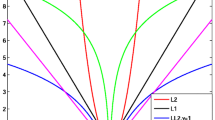Abstract
The reconstruction of signals from their blind compressed measurements is a highly ill-posed problem because the representing basis is unknown. This paper proposes an alternating optimization method to estimate the signal from a given set of blind compressive measurement vectors. The representing coefficients, representing basis (sparsifying basis), and the updated estimate of the signals are identified iteratively. The representing basis is identified using the orthogonal Procrustes method. The signal estimate is updated using \(\ell _1\)-trend filtering. The high computational intensity of the proposed method compared to other existing methods limits its application to non-real-time signal estimation. The proposed method reconstructs the signal uniquely up to a lower error bound.






Similar content being viewed by others
Data Availability
The codes and the synthetic data generated for the current study are available from the corresponding author on request. A working example of the code for speech signal is given in the GITHUB repository. The link to the repository is https://github.com/veenanarayanan28/BCS-using-Orthogonal-Procrustes-method.
References
B. Adcock, N. Dexter, Q. Xu, Improved recovery guarantees and sampling strategies for TV minimization in compressive imaging. SIAM J. Imaging Sci. 14(3), 1149–1183 (2021). https://doi.org/10.1137/20M136788X
A. Beck, M. Teboulle, A fast iterative shrinkage-thresholding algorithm for linear inverse problems. SIAM J. Imaging Sci. 2(1), 183–202 (2009). https://doi.org/10.1137/080716542
S. Boyd, N. Parikh, E. Chu, B. Peleato, J. Eckstein, Distributed optimization and statistical learning via the alternating direction method of multipliers. Found. Trends Mach. Learn. 3(1), 1–122 (2011). https://doi.org/10.1561/2200000016
S.S. Chen, D.L. Donoho, M.A. Saunders, Atomic decomposition by basis pursuit. SIAM J. Sci. Comput. 20(1), 33–61 (1998). https://doi.org/10.1137/S1064827596304010
I. Daubechies, M. Defrise, C. De Mol, An iterative thresholding algorithm for linear inverse problems with a sparsity constraint. Commun. Pure Appl. Math. 57(11), 1413–1457 (2004). https://doi.org/10.1002/cpa.20042
D.L. Donoho, Compressed sensing. IEEE Trans. Inf. Theory 52(4), 1289–1306 (2006). https://doi.org/10.1109/TIT.2006.871582
R. Everson, Orthogonal, but not orthonormal, Procrustes problems. Adv. Comput. Math. 4655–4666 (1997)
S. Gleichman, Y.C. Eldar, Blind compressed sensing. IEEE Trans. Inf. Theory 57(10), 6958–6975 (2011). https://doi.org/10.1109/TIT.2011.2165821
G. Grossi, R. Lanzarotti, J. Lin, Orthogonal Procrustes analysis for dictionary learning in sparse linear representation. PLoS ONE (2017). https://doi.org/10.1371/journal.pone.0169663
Y. Hu, P.C. Loizou, Evaluation of objective quality measures for speech enhancement. IEEE Trans. Audio Speech Lang. Process. 16(1), 229–238 (2008). https://doi.org/10.1109/TASL.2007.911054
K.H. Jin, J.C. Ye, Annihilating filter-based low-rank Hankel matrix approach for image inpainting. IEEE Trans. Image Process. 24(11), 3498–3511 (2015). https://doi.org/10.1109/TIP.2015.2446943
S.J. Kim, K. Koh, S. Boyd, D. Gorinevsky, \(\ell _1\) trend filtering. SIAM Rev. 51(2), 339–360 (2009). https://doi.org/10.1137/070690274
S.G. Lingala, M. Jacob, A blind compressive sensing frame work for accelerated dynamic MRI, in 9th IEEE International Symposium on Biomedical Imaging (ISBI) (2012), pp. 1060–1063
S.G. Lingala, M. Jacob, Blind compressive sensing dynamic MRI. IEEE Trans. Med. Imaging 32(6), 1132–1145 (2013). https://doi.org/10.1109/TMI.2013.2255133
D.G. Luenberger, Y. Ye, Quasi-newton methods, in Linear and Nonlinear Programming. International Series in Operations Research and Management Science, 116 (Springer, US, 2008), pp. 285–317
A. Majumdar, Improving synthesis and analysis prior blind compressed sensing with low-rank constraints for dynamic MRI reconstruction. Magn. Reson. Imaging 33, 174–179 (2015)
A. Majumdar, R. Ward, Learning space–time dictionaries for blind compressed sensing dynamic MRI reconstruction, in IEEE International Conference on Image Processing (ICIP, 2015), pp. 4550–4554
V. Narayanan, G. Abhilash, Reconstruction of signals from their blind compressive measurements, in 2nd IEEE International Conference on Advanced Communication Technologies and Signal Processing (ACTS, 2021), pp. 1–6. https://doi.org/10.1109/ACTS53447.2021.9708321
G. Parthasarathy, G. Abhilash, Entropy-based transform learning algorithms. IET Signal Process. 12(4), 439–446 (2017). https://doi.org/10.1049/iet-spr.2017.0337
G. Parthasarathy, G. Abhilash, Transform learning algorithm based on the probability of representation of signals, in 25th IEEE European Signal Processing Conference (EUSIPCO, 2017), pp. 1329–1333. https://doi.org/10.23919/EUSIPCO.2017.8081424
D.B. Percival, H.O. Mofjeld, Analysis of subtidal coastal sea level fluctuations using wavelets. J. Am. Stat. Assoc. 92(439), 868–880 (1997)
S. Ravishankar, Y. Bresler, MR image reconstruction from highly under sampled k-space data by dictionary learning. IEEE Trans. Med. Imaging 30(5), 1028–1041 (2011). https://doi.org/10.1109/TMI.2010.2090538
S. Ravishankar, Y. Bresler, Closed-form solutions within sparsifying transform learning, in IEEE International Conference on Acoustics, Speech and Signal Processing (ICASSP, 2013), pp. 5378–5382. https://doi.org/10.1109/ICASSP.2013.6638690
S. Ravishankar, Y. Bresler, Blind compressed sensing using sparsifying transforms, in 2015 International Conference on Sampling Theory and Applications (SampTA, 2015), pp. 513–517
S. Ravishankar, Y. Bresler, Efficient blind compressed sensing using sparsifying transforms with convergence guarantees and application to magnetic resonance imaging. SIAM J. Imaging Sci. 8(4), 2519–2557 (2015). https://doi.org/10.1137/141002293
A.K. Roonizi, \(\ell _1\) and \(\ell _2\) trend filtering: a Kalman filter approach [lecture notes]. IEEE Signal Process. Mag. 38(6), 137–145 (2021). https://doi.org/10.1109/MSP.2021.3102900
P.H. Schonemann, A generalized solution of the orthogonal Procrustes problem. Psychometrika 31, 1–10 (1966)
Y. Wang, J. Yang, W. Yin, Y. Zhang, A new alternating minimization algorithm for total variation image reconstruction. SIAM J. Imaging Sci. 1(3), 248–272 (2008). https://doi.org/10.1137/080724265
Author information
Authors and Affiliations
Corresponding author
Additional information
Publisher's Note
Springer Nature remains neutral with regard to jurisdictional claims in published maps and institutional affiliations.
Rights and permissions
Springer Nature or its licensor (e.g. a society or other partner) holds exclusive rights to this article under a publishing agreement with the author(s) or other rightsholder(s); author self-archiving of the accepted manuscript version of this article is solely governed by the terms of such publishing agreement and applicable law.
About this article
Cite this article
Narayanan, V., Abhilash, G. Signal Reconstruction from Blind Compressive Measurements Using Procrustes Method. Circuits Syst Signal Process 42, 2941–2958 (2023). https://doi.org/10.1007/s00034-022-02246-6
Received:
Revised:
Accepted:
Published:
Issue Date:
DOI: https://doi.org/10.1007/s00034-022-02246-6




